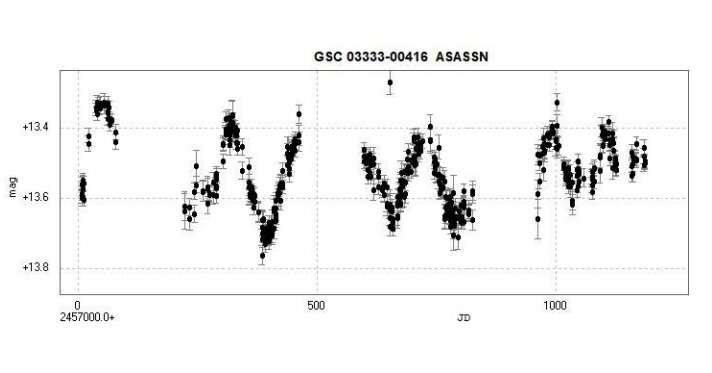June 23, 2020 report
CGCS 673 is a semi-regular variable carbon star, study finds

Astronomers from Malta and Spain have conducted an observational campaign aimed at investigating the periodic behavior of a carbon star known as CGCS 673. The observations found that the studied object is a semi-regular variable star. The discovery is reported in a paper published June 15 on the arXiv pre-print repository.
Carbon stars are giant stars in a late phase of evolution. They are similar to red giants, but their atmospheres contain more carbon than oxygen. Observations show that most classical carbon stars are long-period irregular or semi-regular variable stars.
CGCS 673 (also known as GSC 03333-00416 or CASE 72) was identified as a carbon star in the 1950s. The star is located in the constellation of Perseus and has an effective temperature of about 3,300 K.
When a team of astronomers led by Stephen M. Brincat of Flarestar Observatory in San Gwann, Malta, conducted a study of a neighboring object designated UCAC4 690-029948, they found some hints suggesting that CGCS 673 is a variable source. Therefore, they started a monitoring campaign of this carbon star in order to get more insights into its nature.
The researchers performed photometric observations of CGCS 673 using the Flarestar Observatory, Znith Observatory in Malta and Tacande Observatory on the island of La Palma, Spain. The study was complemented by data from the All Sky Automated Survey for SuperNovae (ASAS-SN).
"Our observational campaign to monitor CGCS 763 was concluded on April 11, 2019, yielding a total number of 348 observations gathered by the observatories," the astronomers wrote in the paper.
By analyzing the collected data, Brincat and his colleagues found that CGCS 763 is a semi-regular (SR) variable with a period of about 135.10 days and a mean amplitude in V-band of approximately 0.188 mag. SR variables usually have periods between 20 and 2,000 days, with amplitudes ranging from 1.0 to 2.0 mag in the V-band.
Moreover, the researchers identified a noticeable periodicity in the light changes of CGCS 673, occasionally interrupted by a period of irregular variability.
"The light curve shows that the star is semi-regular in nature as regular cycles are interrupted by periods of irregularity," the paper reads.
The astronomers noted that these results, together with a color index obtained from professional databases, confirm that CGCS 763 belongs to the semi-regular class of variable stars. As a newly detected variable source, CGCS 763 received a unique identifier from the American Association of Variable Star Observers (AAVSO) as (AAVSO UID) 000-BMZ-492.
CGCS 763 is therefore the latest addition to the still relatively short list of SR variable carbon stars. Further observations of this star, especially including more detailed photometry, could reveal more information about the properties of this variable object.
More information: Carbon Star CGCS 673 identified as a Semi-regular variable star, arXiv:2006.07289 [astro-ph.SR] arxiv.org/abs/2006.07289
© 2020 Science X Network




















